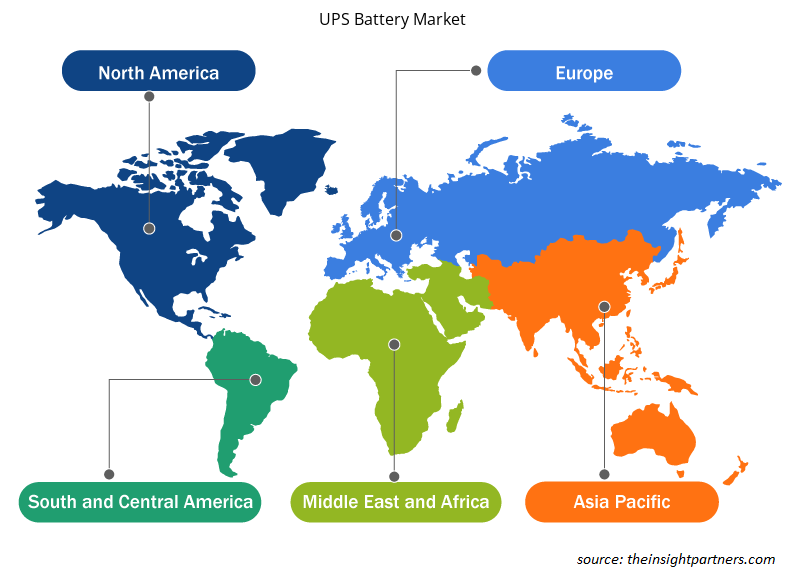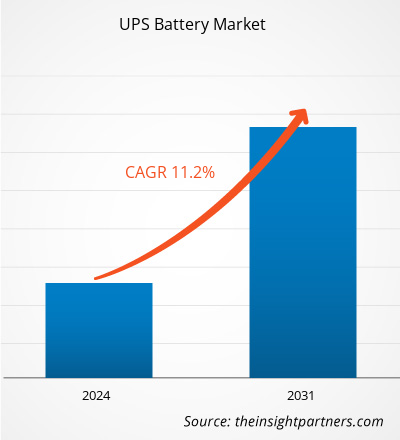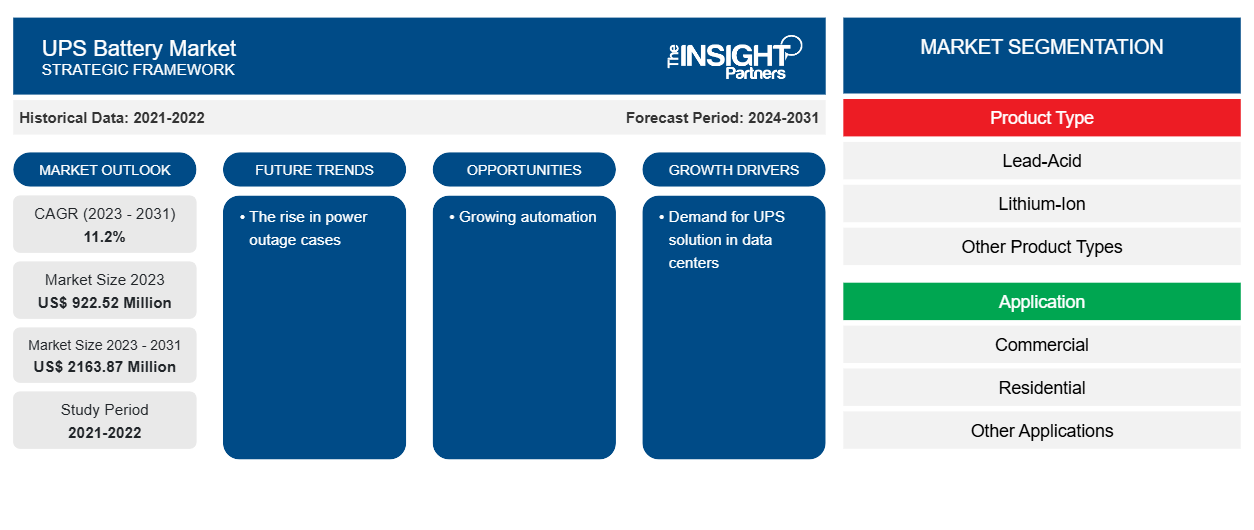UPS 电池市场规模预计将从 2023 年的 9.2252 亿美元增至 2031 年的 21.6387 亿美元。预计 2023-2031 年期间市场复合年增长率将达到 11.2%。停电事件的增加以及住宅和商业部门的增长可能仍是市场的主要趋势。
UPS电池市场分析
企业和工业领域大型数据中心的不断建设产生了对 UPS 系统的需求,这进一步推动了 UPS 电池市场的发展。对任务关键型电子设备、设施、小工具、关键基础设施等的持续供电需求进一步推动了市场的增长。全球停电事件的增加进一步要求 UPS 解决方案,这进一步推动了 UPS 电池市场的增长。
UPS电池市场概况
不间断电源 (UPS) 电池或 UPS 电源是一种电源系统,可在电源故障或断电时用作电力存储或备用电源。它通常用于保护硬件,例如数据中心、计算机、电信设备或其他电气设备,意外的电源中断可能会导致人员受伤、死亡、严重的业务中断或数据丢失。数据中心和工业部门的兴起推动了 UPS 电池市场的增长。
定制此报告以满足您的需求
您可以免费定制任何报告,包括本报告的部分内容、国家级分析、Excel 数据包,以及为初创企业和大学提供优惠和折扣
-
获取此报告的关键市场趋势。这个免费样品将包括数据分析,从市场趋势到估计和预测。
UPS 电池市场驱动因素和机遇
数据中心对 UPS 解决方案的需求
UPS 解决方案是任务关键型数据中心基础设施的关键系统。UPS 系统的存在可为数据中心提供稳定、高效的电力。当主电源断电时,它可以为大型数据中心提供支持。用户需要更高的正常运行时间。这一因素导致需要增加电力以确保数据中心高效运行。数据中心的 UPS 系统可在断电后几毫秒内提供准确的电量。因此,数据中心市场的不断增长促进了 UPS 电池市场的增长。
UPS电池的广泛终端用户
UPS 电池市场的主要终端用户包括商业、住宅和工业部门。食品和饮料、制药、发电厂和航空航天是一些关键行业,周围可能存在电源故障和极高的环境温度。由于 UPS 电池是 UPS 的关键组件;它负责 UPS 的良好性能和长寿命。除了它们的用途之外,数据中心、企业、家用电器和电器设备也是 UPS 的其他应用。随着 UPS 的普及,UPS 电池的范围将得到扩大。
UPS 电池市场报告细分分析
有助于得出 UPS 电池市场分析的关键部分是产品类型和应用。
- 根据产品类型,UPS 电池市场分为铅酸电池、锂离子电池和其他产品类型。锂离子电池领域预计将以最高的复合年增长率增长。
- 根据应用,市场分为商业、住宅和其他应用。商业领域在 2023 年占据了相当大的市场份额。
UPS 电池市场份额(按地区)分析
UPS电池市场报告的地理范围主要分为五个区域:北美、亚太、欧洲、中东和非洲、南美和中美。
2023 年,亚太地区占据了最大的市场份额。数据中心建设的增加产生了对不间断电源的需求,从而推动了该地区 UPS 电池市场的增长。政府当局提供补贴以及市场参与者对建设超大规模数据中心的投资增加进一步推动了市场的发展。住宅领域的增长正在推动市场增长。
UPS电池市场区域洞察
Insight Partners 的分析师已详尽解释了预测期内影响 UPS 电池市场的区域趋势和因素。本节还讨论了北美、欧洲、亚太地区、中东和非洲以及南美和中美洲的 UPS 电池市场细分和地理位置。

- 获取 UPS 电池市场的区域特定数据
UPS 电池市场报告范围
| 报告属性 | 细节 |
|---|---|
| 2023 年的市场规模 | 9.2252亿美元 |
| 2031 年市场规模 | 21.6387亿美元 |
| 全球复合年增长率(2023 - 2031) | 11.2% |
| 史料 | 2021-2022 |
| 预测期 | 2024-2031 |
| 涵盖的领域 |
按产品类型
|
| 覆盖地区和国家 |
北美
|
| 市场领导者和主要公司简介 |
|
UPS 电池市场参与者密度:了解其对业务动态的影响
UPS 电池市场正在快速增长,这得益于终端用户需求的不断增长,而这些需求又源于消费者偏好的不断变化、技术进步以及对产品优势的认识不断提高等因素。随着需求的增加,企业正在扩大其产品范围,进行创新以满足消费者的需求,并利用新兴趋势,从而进一步推动市场增长。
市场参与者密度是指在特定市场或行业内运营的企业或公司的分布情况。它表明在给定市场空间中,相对于其规模或总市场价值,有多少竞争对手(市场参与者)存在。
在 UPS 电池市场运营的主要公司有:
- 神户电池有限公司
- 东宾夕法尼亚制造公司
- 伊顿公司
- 埃克塞德工业有限公司
- FIAMM 能源技术有限公司
- GS汤浅国际有限公司
免责声明:上面列出的公司没有按照任何特定顺序排列。

- 获取 UPS 电池市场顶级关键参与者概览
UPS 电池市场新闻及最新发展
UPS 电池市场通过收集一手和二手研究后的定性和定量数据进行评估,其中包括重要的公司出版物、协会数据和数据库。以下列出了 UPS 电池市场的一些发展情况:
- C&D Technologies 是数据中心行业不间断电源 (UPS) 储能解决方案的全球领导者,推出了其优质 Pure Lead Max (PLM) VRLA 电池。Pure Lead Max 是 C&D 产品线中使用寿命最长的 UPS 系统 VRLA 电池,并拥有行业领先的八年保修期。(来源:C&D Technologies,新闻稿,2023 年 3 月)
- 伊顿宣布在全球推出 9PX 锂离子不间断电源 (UPS)。伊顿在备用电源解决方案中提供创新锂离子电池功能方面处于领先地位,其新型 UPS 比阀控铅酸 (VRLA) 电池供电的 UPS 技术具有更长的电池寿命和更小的占地面积,使其成为从医疗保健到教育等分布式“边缘”环境和轻工业应用的理想选择。(来源:伊顿,新闻稿,2021 年 7 月)
UPS 电池市场报告覆盖范围和交付成果
“UPS 电池市场规模和预测(2021-2031 年)”报告对市场进行了详细分析,涵盖以下领域:
- 范围内涵盖的所有关键细分市场的全球、区域和国家层面的 UPS 电池市场规模和预测
- UPS 电池市场趋势以及市场动态,如驱动因素、限制因素和关键机遇
- 详细的 PEST/波特五力分析和 SWOT 分析
- UPS 电池市场分析涵盖主要市场趋势、全球和区域框架、主要参与者、法规和最新市场发展
- 行业格局和竞争分析,涵盖市场集中度、热图分析、知名参与者以及 UPS 电池市场的最新发展
- 详细的公司简介
- 历史分析(2 年)、基准年、预测(7 年)及复合年增长率
- PEST和SWOT分析
- 市场规模、价值/数量 - 全球、区域、国家
- 行业和竞争格局
- Excel 数据集
近期报告
相关报告
客户评价
购买理由
- 明智的决策
- 了解市场动态
- 竞争分析
- 客户洞察
- 市场预测
- 风险规避
- 战略规划
- 投资论证
- 识别新兴市场
- 优化营销策略
- 提升运营效率
- 顺应监管趋势























 获取免费样品 - UPS电池市场
获取免费样品 - UPS电池市场